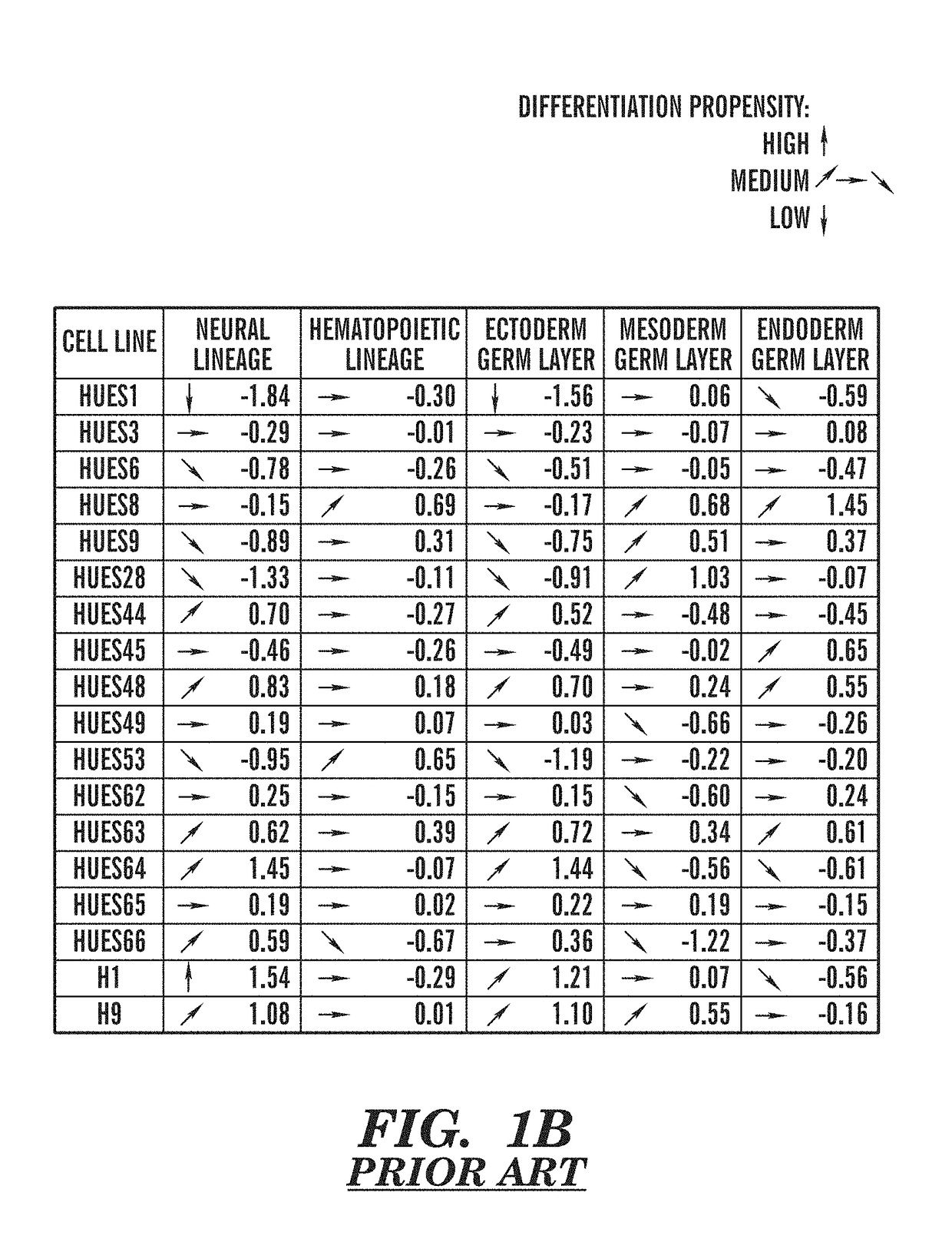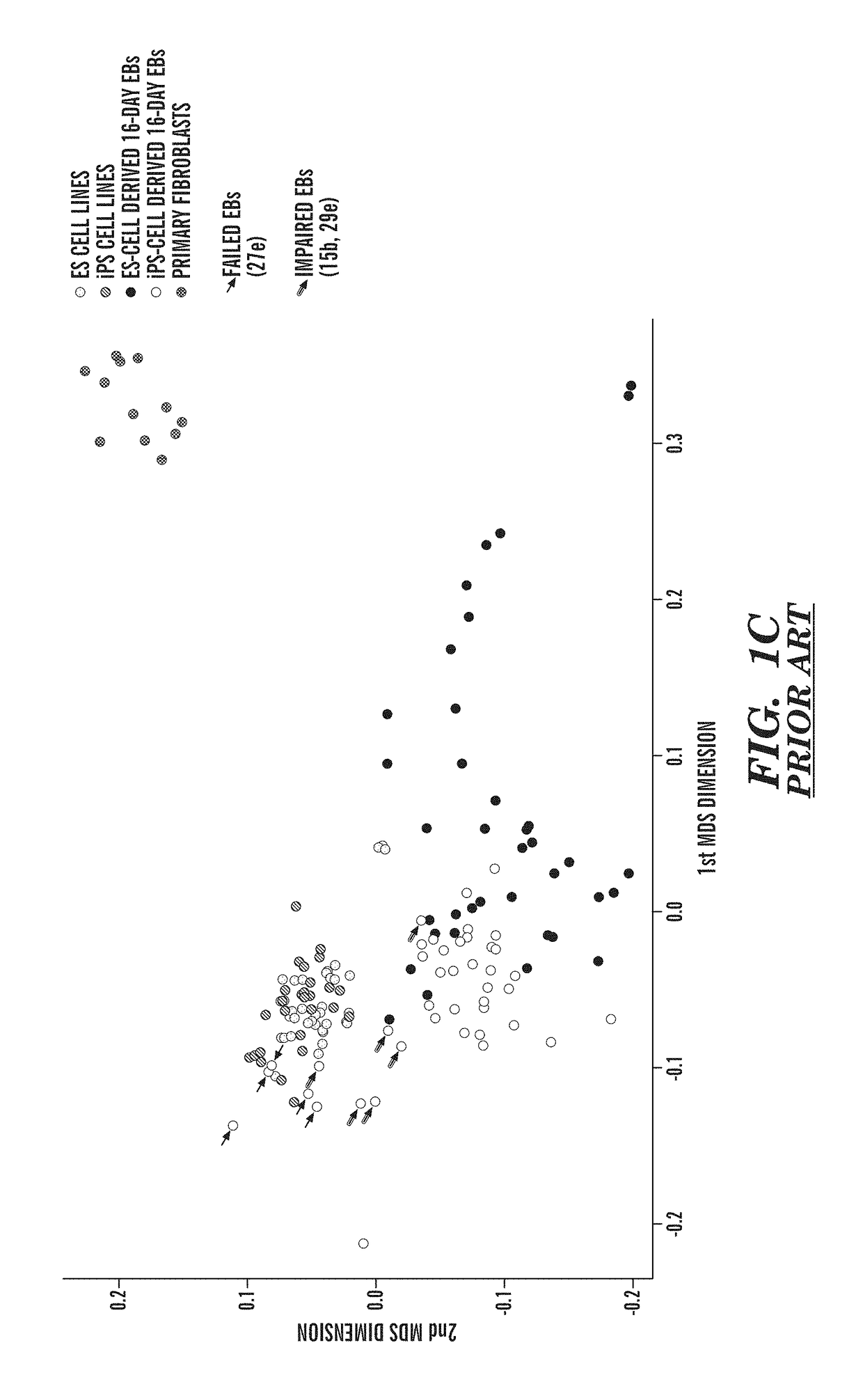Early developmental genomic assay for characterizing pluripotent stem cell utility and safety
a technology of early developmental genomics and pluripotent stem cells, applied in the field of arrays and methods for characterizing pluripotent stem cell populations, can solve the problems of teratoma formation, cumbersome systems to assess pluripotency, and difficulty in predicting the behavior of pluripotent stem cell lines, and achieve rapid and inexpensive screening of cells, high throughput screening, and rapid identification and selection of cells
- Summary
- Abstract
- Description
- Claims
- Application Information
AI Technical Summary
Benefits of technology
Problems solved by technology
Method used
Image
Examples
example 1
Variation in Gene Expression Between hES Cell Lines
[0446]There are many properties of a given ES cell line that could influence its early developmental gene expression profile and its potential differentiation. These could include the genetic background of a cell line, the way in which a line is cultured, selective pressure applied by extended in vitro growth, or unexplained stochastic noise. Before one can attempt to study the potential underlying causes of the variance in pluripotent stem cell line behavior, it is crucial to first determine both the nature and extent of variation that exists within a substantial cohort of lines.
[0447]Table 4: Summary of cell lines used in the high-throughput experiments. *verified by presence / absence of chrY and evidence of X-chromosome inactivation in the RRBS, microarray and / or Nano String data.
TABLE 4SiblingPairs(ES) / PassagePassagePassage No.DonorDonorDonorNo. forNo. forfor LineageCell LineReferenceAgeSex*(iPS)RRBSMicroarrayScorecardHUES1Cowan ...
example 2
Toward High-Throughput Evaluation of Pluripotent Cell Quality and Utility
[0450]The inventors have demonstrated use of the differentiation assays as disclosed herein to design a “lineage scorecard” that can predict the differentiation propensities of any pluripotent cell line. The scorecard output provides a systematic estimate of a cell line's differentiation propensities.
[0451]Here, the inventors demonstrate that only one differentiation gene expression assay of early developmental genes is required to quantitative and characterize a stem cell without compromising the accuracy of the score-card relative to methods involving more than one type of assay, e.g., methylation assay, gene expression assay and a differentiation assay, or gene expression on differentiated or spontaneously differentiated stem cells.
[0452]As disclosed herein, the quantitative differentiation assay could be performed alone as a single indicator of the differentiation potential of the stem cells line. Additiona...
example 3
[0453]The inventors also investigated how robust and reproducible the results from the “scorecard” remained when the inventors compared the same pluripotent stem lines across several passages and between independent labs. Because the inventors' methods for analyzing DNA methylation and transcription have been shown to be reproducible (Gu et al., 2010; Irizarry et al., 2005) and because the inventors have already investigated how these measures change with passage (data not shown), the inventors focused on the reproducibility of the quantitative differentiation assay. Because differentiation of ES cells in EBs is likely to be sensitive to differences in such parameters as physical handling, media renewal and plasticware, the inventors assessed how predictive the results from the differentiation assay would be of cell line behavior in another lab and with a distinct investigator.
[0454]To further confirm the robustness and reproducibility of the scorecard for predicting the behavior of...
PUM
| Property | Measurement | Unit |
|---|---|---|
| time | aaaaa | aaaaa |
| time | aaaaa | aaaaa |
| time | aaaaa | aaaaa |
Abstract
Description
Claims
Application Information
 Login to View More
Login to View More - R&D
- Intellectual Property
- Life Sciences
- Materials
- Tech Scout
- Unparalleled Data Quality
- Higher Quality Content
- 60% Fewer Hallucinations
Browse by: Latest US Patents, China's latest patents, Technical Efficacy Thesaurus, Application Domain, Technology Topic, Popular Technical Reports.
© 2025 PatSnap. All rights reserved.Legal|Privacy policy|Modern Slavery Act Transparency Statement|Sitemap|About US| Contact US: help@patsnap.com



